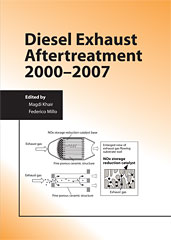Technical Paper
Combustion Chamber Development for Flat Firedeck Heavy-Duty Natural Gas Engines
2024-04-09
2024-01-2115
The widely accepted best practice for spark-ignition combustion is the four-valve pent-roof chamber using a central sparkplug and incorporating tumble flow during the intake event. The bulk tumble flow readily breaks up during the compression stroke to fine-scale turbulent kinetic energy desired for rapid, robust combustion. The natural gas engines used in medium- and heavy-truck applications would benefit from a similar, high-tumble pent-roof combustion chamber. However, these engines are invariably derived from their higher-volume diesel counterparts, and the production volumes are insufficient to justify the amount of modification required to incorporate a pent-roof system. The objective of this multi-dimensional computational study was to develop a combustion chamber addressing the objectives of a pent-roof chamber while maintaining the flat firedeck and vertical valve orientation of the diesel engine.


